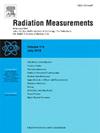Assessment of Cerenkov optical noise in a brachytherapy scintillating fibre dosimeter with an air-core Ag-PTFE light guide
IF 2.2
3区 物理与天体物理
Q2 NUCLEAR SCIENCE & TECHNOLOGY
引用次数: 0
Abstract
Plastic scintillating fibre dosimeters have been the subject of multiple studies in the field of medical dosimetry, due to their notable dosimetric properties, including water equivalence, small size and absence of energy and dose rate dependence. The main drawback of this dosimeter type in high dose-rate brachytherapy is the presence of Cerenkov photons produced by electrons with velocities exceeding the speed of light in the fibre plastic medium. In this work, aimed at minimizing Cerenkov noise at its source in a prototype scintillation fibre dosimeter, the plastic light guide exposed to the radiation field was replaced by an air-core Ag-PTFE light guide of miniature size. Cerenkov-to-signal ratio was first assessed in fibre bundles using a dedicated experimental setup and simulations. This ratio was found of about for scintillating fibres when exposed to radiation in the energy range 1–2 MeV. The performance of the air-core Ag-PTFE light guide dosimeter was then studied, resulting in a decrease of the Cerenkov light in the total signal from to less than 0.3%, compared to the standard dosimeter with a plastic optical light guide. The counterpart of this substantial reduction of optical noise is a reduction of 40% in the dosimeter light collection efficiency. However, this is not a limiting feature of this Cerenkov-free dosimeter, since further optical optimizations are possible, in addition to the use of a high-gain and high-sensitivity photodetector for its readout.
采用空心Ag-PTFE光导的近距离闪烁光纤剂量计中切伦科夫光噪声的评估
塑料闪烁纤维剂量计由于其显著的剂量特性,包括水等效、体积小以及不依赖于能量和剂量率,已成为医学剂量学领域的多项研究课题。在高剂量率近距离放射治疗中,这种剂量计的主要缺点是存在由纤维塑料介质中速度超过光速的电子产生的切伦科夫光子。在这项工作中,为了将闪烁光纤剂量计原型中的切伦科夫噪声最小化,将暴露在辐射场中的塑料光导替换为微型尺寸的空芯Ag-PTFE光导。切伦科夫信号比首先通过专用的实验装置和模拟在光纤束中进行评估。当暴露在能量范围为1 - 2 MeV的辐射中时,发现闪烁纤维的这一比率约为~ 1%。然后研究了空气芯Ag-PTFE光导剂量计的性能,结果表明,与带有塑料光学光导的标准剂量计相比,总信号中的切伦科夫光从~ 50%减少到小于0.3%。这种光学噪声的实质性减少的对应物是在剂量计光收集效率的40%的减少。然而,这不是这个无切伦科夫剂量计的限制功能,因为进一步的光学优化是可能的,除了使用一个高增益和高灵敏度的光电探测器为其读出。
本文章由计算机程序翻译,如有差异,请以英文原文为准。
求助全文
约1分钟内获得全文
求助全文
来源期刊

Radiation Measurements
工程技术-核科学技术
CiteScore
4.10
自引率
20.00%
发文量
116
审稿时长
48 days
期刊介绍:
The journal seeks to publish papers that present advances in the following areas: spontaneous and stimulated luminescence (including scintillating materials, thermoluminescence, and optically stimulated luminescence); electron spin resonance of natural and synthetic materials; the physics, design and performance of radiation measurements (including computational modelling such as electronic transport simulations); the novel basic aspects of radiation measurement in medical physics. Studies of energy-transfer phenomena, track physics and microdosimetry are also of interest to the journal.
Applications relevant to the journal, particularly where they present novel detection techniques, novel analytical approaches or novel materials, include: personal dosimetry (including dosimetric quantities, active/electronic and passive monitoring techniques for photon, neutron and charged-particle exposures); environmental dosimetry (including methodological advances and predictive models related to radon, but generally excluding local survey results of radon where the main aim is to establish the radiation risk to populations); cosmic and high-energy radiation measurements (including dosimetry, space radiation effects, and single event upsets); dosimetry-based archaeological and Quaternary dating; dosimetry-based approaches to thermochronometry; accident and retrospective dosimetry (including activation detectors), and dosimetry and measurements related to medical applications.
 求助内容:
求助内容: 应助结果提醒方式:
应助结果提醒方式:


